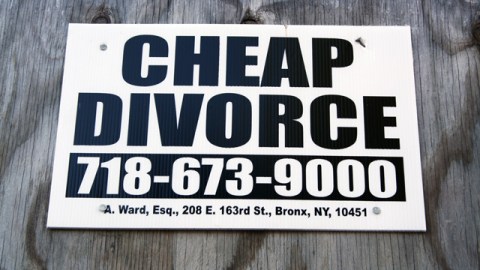Is Keeping Up With the Joneses Grounds for Divorce?

It is widely known that the income gap between the rich and the poor in North America over the past 30 years has evolved from a narrow crack to a yawning fissure. You may be tempted to think that this is only problem for the poor—and that those who have seen their incomes climb have suffered no adverse effects as a result of the divide. New research (incidentally by one of my favourite economists, Robert Frank) shows that rising inequality is driving up the divorce rate and it isn’t poverty that is the culprit; it is the constant pursuit of keeping up with your neighbours.
Personal savings rates in the U.S. have been falling since the mid-1970s, from 10% in the mid-70s to less than zero a couple of years ago. While there are a variety of reasons for that decline, the main reason has to be that people are consuming more of everything—and that consumption is growing more quickly than income. For example, the median size of a newly constructed house increased from 1,600 square feet in 1980 to over 2,100 square feet in 2001—double the increase in median household earnings.
Inequality hasn’t caused savings to fall; in fact it is the other way around. Think about it this way: Say that you are in a community and everyone has the same income, same size house, same car and all their wives are just as pretty (just for good measure). Now imagine that one person has a big increase in income. He builds a bigger house and gets a nicer car (maybe a Maserati, that’s what I would get). The people around him think, “Well, if he deserves a big house and a Maserati then I do too.” They reduce their savings, build and buy. This effect then expands out around them, cascading into segments of society where the increase in consumption causes real hardship not because their income is too low, but because trying to keep up with their neighbours pushes their consumption too high.
Before I talk about divorce, let me take a moment to describe to you how inequality has increased in the U.S. I have to do this, because the evidence is mind-boggling. In the years directly after the Second World War, incomes in the U.S. grew steadily. The incomes of those at the top 5% of income distribution grew more slowly than those in the bottom 20%—rising 86% compared to 116%. This is the reason that economists call that period in history “The Great Compression.” Over that period the income gap between the wealthy and the poor diminished.
That trend reversed in the 1970s, and during the 24-year period from 1979 to 2003 the pre-tax income of people at the bottom 20% of the income distribution remained essentially unchanged. People in the top income bracket saw their incomes grow, but at a much slower pace than in the 25 years after the war (only 68%). Growth overall was slow, and the few gains went almost entirely to the top earners. This is was enough to create a significant divide between income classes.
When we take into consideration the effect of changes in tax laws (illustrated below), the results are startling. After-tax incomes of the bottom 20% increased 9% between 1979 and 2003 while those in the top 1% saw their incomes increase 201%. Let the cascade of consumption begin!

So the rich get richer, and everyone else races to keep up with the consumption levels of those around them. Excess consumption puts stress on everyone—people start working longer hours, making longer commutes, and going bankrupt more often. This puts strain on their marriages as well. The evidence in this paper suggests that in counties where the inequality is highest, divorce rates are high as well. In fact, a 1% increase in inequality is associated with a 1.2% increase in the proportion of people who are divorced. If we look at just the period from 1990 to 2000, the increase in inequality can account for an increase of 5.34% in the number of divorces. That is a very large effect.
One thing that is not addressed in this research, probably because reliable data is almost impossible to find, is how inequality is related to infidelity. Maybe that guy in the story I told you above doesn’t just get a Maserati, maybe he gets a new (younger, prettier) wife as well. It is easy to argue that the increase in divorce is a function of the financial and time pressures created by excess consumption, but humans, being what they are, don’t confine their competition with each other to material objects. Maybe when keeping up with the Joneses, it’s Mr. Jones that someone has her eye on.
— Levine, Adam Seth, Frank, Robert H. and Dijk, Oege, “Expenditure Cascades” (September 13, 2010).





